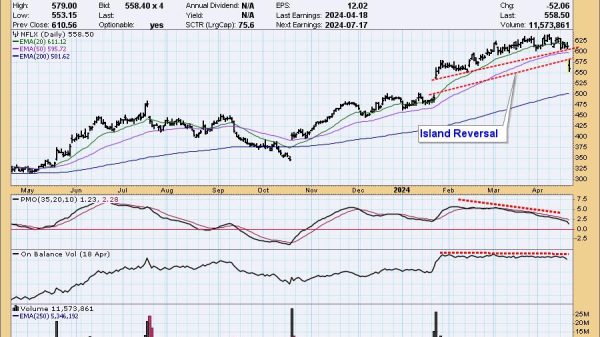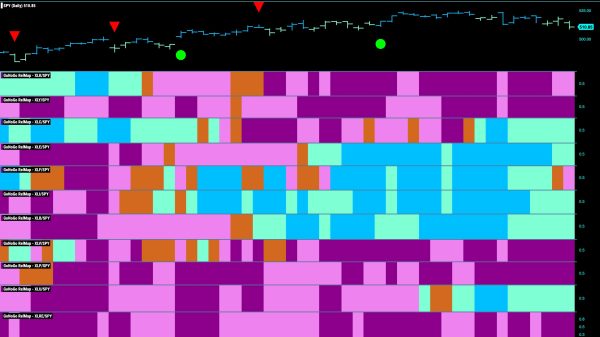2022 was a challenging year for investors, and, so far, the stock market in 2023 has had its fair share of challenges. The fallout of some banks came as a surprise to many investors; how can retail traders improve their trading results in 2023 in light of such unexpected events? That’s a question on every investor’s mind and involves several facets that range from tools and educational resources to behavioral biases.
A recent conversation between Steve Lanzone of Bloomberg Radio and David Keller, CMT, our chief market strategist, sheds some light on how investors can better navigate the markets. It involves tools, educational resources, and behavioral biases. How can investors apply these different facets when investing? Let’s unpack.
A link to the interview is available at the end of this article.
Rotation Among Asset Classes
The stock market is never static. Sometimes, stocks outperform bonds, gold outperforms stocks, or commodities outperform stocks. And within stocks, sometimes Consumer Discretionary stocks outperform Consumer Staples, Technology outperforms Utilities, large caps outperform mid-caps/small caps, growth outperforms value, and so on. This is why it’s important for investors to be aware of these different rotations. If you start seeing growth stocks deteriorating, it may be time to comb through your charts to identify the areas of the market that are showing strength.
For example, during the banking fiasco in March 2023, banks got slammed, and investors moved their assets to other areas, such as the Technology sector, bonds, and gold. The chart below shows the ratio between the Technology Select Sector SPDR (XLK) and the Financial Select Sector SPDR (XLF). You can’t miss the steep rise from early March. This indicates that investors are moving into technology stocks such as Microsoft Corp. (MSFT), Apple Inc. (AAPL), Nvidia Corp (NVDA), and Salesforce, Inc. (CRM).
CHART 1: ARE INVESTORS TURNING TO TECHNOLOGY STOCKS FOR SAFETY? If you look at the performance of Technology to Financial, investors are pulling out of bank stocks and investing in technology stocks.Chart source: StockCharts.com. For illustrative purposes only.
Remember, during volatile market conditions, rotating in and out of different asset classes or sectors can equate to being an active trader. Nothing wrong with that, but it means you have to be engaged with the markets. One week can make a difference. So it goes without saying that you have to manage your risks, because small losses could lead to large losses.
If a stock or ETF has seen a significant decline, it may be tempting to pick it up at a bargain. But you’d be better off taking a step back and considering why the price is low.
Can you recollect a similar situation from the past?How did that trade work out?If you were to do it again, how would you trade it?
A stock or ETF may be well below its 200-day moving average, and if your criteria are to buy stocks above the 200-day moving average because, well, nothing good happens below the 200-day, you’re better off waiting on the sidelines.
Tackling Trading Emotions
One of the biggest challenges a trader faces is emotions. It’s much deeper than fear and greed. Within the realm of emotions are several biases, and one that often comes in the way of making sound trading decisions is confirmation bias. That’s when you find enough evidence to support your directional bias and convince yourself that your decision is correct—and because you believe your decision is correct, if the trade goes against you, you refuse to exit the position. It could end up being a losing position for far too long.
Another bias that investors face is endowment bias. That’s when you get emotionally attached to your positions. If you were attached to that big bank stock that you’ve been holding for years, your unwillingness to let it go may be silently hurting you. That stock doesn’t care if it hurt your feelings. Why should you hate to let it go?
These types of biases are part of human nature and changing them will take great effort. The market always wins. How can you come close to defeating it?
The 2023 stock market may be volatile, but that doesn’t mean trading opportunities don’t exist. Your best path to take advantage of the market is to establish a daily routine, make a checklist, and be disciplined.
Your Trading Game Plan
Here’s the view from Your Dashboard:
☑ Check the Market Overview (1). How are the US equity indexes performing? Scroll through the different indexes under the Equities tab and determine if they’re in an uptrend, trading sideways, or in a downtrend. View the charts in different time frames—intraday, daily, weekly, and monthly. Do all timeframes confirm the same direction? Are all indexes trending in the same direction, or are they different? What about bonds, commodities, and crypto? Having this big-picture view of the market is a great way to engage with the market.
☑ Check the Sector Summary (2). Know which sectors are the top and bottom performers. One day doesn’t make a trend, so it helps to look at a longer-term view. Click on Sector Summary at the bottom of the panel (3) and select a longer time period, such as three or six months, from the “period” drop-down menu. If, for example, Technology is the top-performing sector, select the Sector Summary for the Technology sector to identify the top sub-sectors. If semiconductors are at the top, select it from the Name column to see which stocks make up the semiconductor sub-sector. You can then sort these based on the different columns.
☑ Identify the strongest stocks or exchange-traded funds (ETFs). Consider the top three sectors and sub-sectors and add five to ten of the strongest stocks you find there to your ChartLists.
☑ Do your due diligence. Set up the charts with the indicators you prefer to look at and add trend-following indicators, breadth indicators, volume indicators, and volatility indicators. There are several indicators to choose from, so choose carefully, because you don’t want your charts to get too crowded. Use indicators that you understand well, and when you choose indicators, make sure they’re not redundant. You want to cover different facets of price action. Here are a few to consider:
Trend following. Trendlines, moving averages, average directional index (ADX).Breadth indicators. Advance-decline line, bullish percent index, McClellan Oscillator.Volume indicators. Relative volume (RVOL), negative volume index (NVI), on-balance volume (OBV).Volatility indicators. TTM Squeeze, average true range (ATR), Bollinger Band Squeeze®.
☑ Trading setup. Look through all your charts regularly and get to know all of them. Ask yourself if you’d be a buyer or a seller in the prevailing market environment. If you’d be a buyer, you want to buy into strength. Identify the industries, ETFs, mutual funds, and stocks that are outperforming the market.
Are they trending higher?Do they show strength?Do all indicators confirm a buy?Is the security showing increased participation?
If everything checks out, you may want to hit that buy button. If the stock acts the way you had hoped, ride the trade. But if you start seeing signs of price not going in your favor, be ready to sell the position. You never know how low a stock will fall. A $2 drop in price could drop another $2 the next day and continue heading lower. Your small loss could become a very large loss.
The Bottom Line
Following routines and checklists doesn’t mean you’ll have no losing trades. You will still have losses, but the key is to keep your losses small. And given how the 2023 stock market has played out so far, it may be worth your while to spend time establishing a trading game plan that is logical and aligns with your lifestyle. The key is to have the discipline to follow it so that your emotions will have less of an influence on your trading decisions.
Disclaimer: This blog is for educational purposes only and should not be construed as financial advice. The ideas and strategies should never be used without first assessing your own personal and financial situation, or without consulting a financial professional.






















